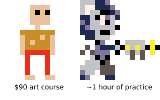|
>>
|
No. 14831
[Edit]
File
170195462534.png
- (7.42KB
, 640x400
, 2022-09-21-7.png
)

Here's how pixel shit ends up being made: Some sap wants to become an indie game developer with no art and no programming knowledge. They look up tutorials on YouTube and watch the same five to ten videos everybody else does, if they're particularly unfortunate they end up FOMO-ing into some Udemy course made by the guy. Maybe they buy a book like Pixel Logic. Maybe they download a pack of those Saint11 .gifs.
However, all of these resources just regurgitate the same few bullet points about 'silhouettes', 'hue shifting', 'shading practices', 'limited palette', 'squash and stretch', et cetera, et cetera. This waters down what constitutes quote-unquote 'good pixel art' to what is on a list. None of these YouTube tutorials or online courses or artbooks teach you how to make a good looking menu, or what hardware had what kind of limitations and techniques that went around that, or the culture of specific regions and eras. Worse yet, none of these tell you what not to do outside of pixel art, at which point these developers will just move to watching other YouTube tutorials on how to use pixel filters on 3D models or software rendered glows or fog.
This is why all pixelshit looks the same, why all of them have stick figures with one pixel beady eyes, why you see so many characters with puffed out chests and legs apart and visibly breathing, why every lantern or lamp has a glow, why every tree and every cave wall and every ground texture is blobb-ish with the darkest layer on bottom and all other painted on top of that. It's all people learning from the same select few resources who then pat each other on the back with the meme white laurels for how good they followed the list.
I made this pic last year as an experiment to see what I can do without any of that poison after finding a tutorial low-key self-advertising for an online course with a 90$ base price tag.
Post edited on 7th Dec 2023, 5:26am
|